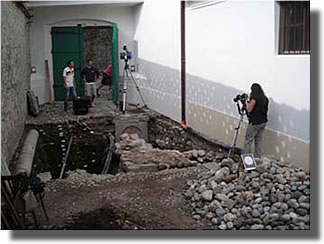CIVIDALE DEL FRIULI
Church of San Giovanni
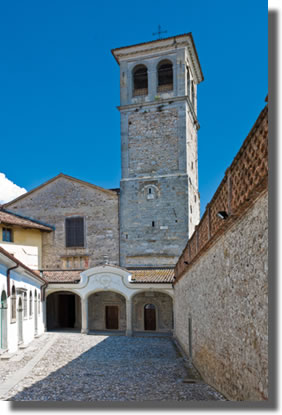 San Giovanni, the Palace Church used by the royal court in the early Longobard period, later became a Monastic worship centre. It had originally dedicated solely to John the Baptist, and was later dedicated also to John the Evangelist, and is first mentioned in a document dating from 830 A.D., when its domains bordered with those of the Monastery of Santa Maria.
San Giovanni, the Palace Church used by the royal court in the early Longobard period, later became a Monastic worship centre. It had originally dedicated solely to John the Baptist, and was later dedicated also to John the Evangelist, and is first mentioned in a document dating from 830 A.D., when its domains bordered with those of the Monastery of Santa Maria.
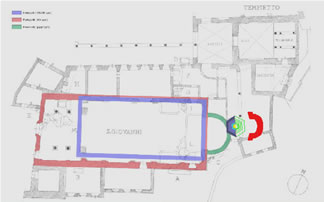
The plant and the façade of San Giovanni
At a later date the Church was incorporated into the Monastic complex, at the time in which Berengarius I°allowed the Western section of the Gastaldaga to be given over to the Monastery for its enlargement, either in 889-890 A.D. (the third year of his reign as King) or in 917-918 (the third year of his reign as Emperor).
The research of Hjilmar Torp indicates that the original building consisted of a small rectangular building ending with a flat wall with no apse; as in the case of the Tempietto nearby, the presbyterial area was emphasized by a slightly raised floor and a narrower width compared to the hall. A rectangular atrium was situated, or was probably leaned against the façade during Early Middle Ages, as proved by documentary evidence from recent excavations and survey.

San Giovanni and an interior view
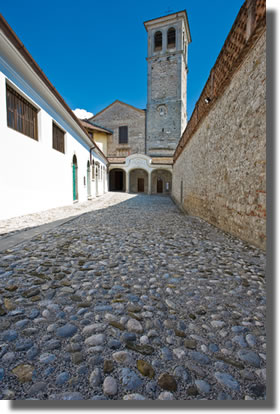 The area of the excavations |
The sculptural elements belonging to this phase are the following: a lunette decorated with peacocks facing each other among floral motifs, an architrave with a frieze showing lambs bearing crosses, which can be dated to the end of the 6th and the beginning of the 7th century, and finally a series of artefacts belonging to the burials of Longobard nobles, discovered here in 1751; among these are a small golden cross and a beautiful golden disc bearing the figure of a stag, dating to the first half of the 7th century.
|
This evidence points to the fact that around that time the Church of San Giovanni represented a privileged burial place for the Longobard aristocracy, which would explain its location close to the royal court.
The Church’s importance throughout Longobard nomination – and after its demise – is proved by the many sculptures dating from the 8th century or to the Carolingian period, which relate to later work carried out to embellish its interior decoration.
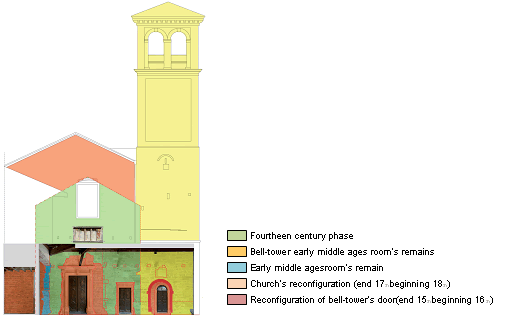
Scheme of the building phases of the church to be read on the façade
The Church was placed immediately to the south-east of the Tempietto, and its architectural appearance today is the result of continual remodelling during medieval and renaissance times. It comprises of a large rectangular hall with a deep semi-circular apse facing east.
The 2008 excavations in the courtyard behind the apse of San Giovanni - which are still visible and can be visited by the public - brought to light an additional place of worship with an apse at its eastern end, and which was built within the area of some earlier rooms with mosaic floors. The enclosures of those earlier spaces have been preserved because they include evidence that a more recent crushed earthenware floor was laid inside the semicircular perimeter of the new apse, and also continued outside, creating a sort of usable space beyond the apse.
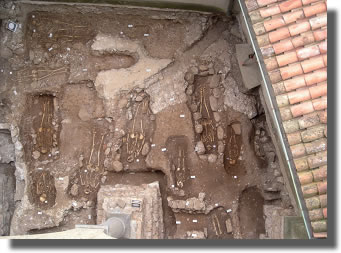
Burials discovered in the courtyard behind the apse
Within the space to which the apse was attached, and whose perimeter walls have not been found, were found the remains of a brick-built depression paved with marble slabs, and whose sides were finished in a crushed earthenware mortar.
It is possible that this depression, of which only the eastern side has been preserved, but which lines up with the centre of the apse and appears to have been hexagonal in shape, was a baptismal font.
It appears to have been at a lower level than the original floor, and to have had two or three steps down, for access.
And it is very suggestive to note that the perimeter size of this depression is the same as that of a small hexagonal arched arcade for a baptisimal font, preserved in the Archaeological Museum, whose workmanship can be associated with that of the workshops that made the coronation for the Cathedral baptismal font (Tegurium), commissioned by the Patriarch Callixtus and sculpted in the second quarter of the 8th century. It is also likely that this arched arcade, a decorative feature found on many other early baptismal fonts, was part of the font used by the royal court.
Within the Longobard Gastaldaga, the complex of the Church of San Giovanni probably therefore also included, right from the beginning, a baptistery standing east of the Church and apparently connected to it. This would have been more than justified by the importance of the location, which was the traditional place of worship for the Longobard nobility of Cividale, and may also have initially been specifically associated with the adhesion of the Longobards to Arian christianity.




